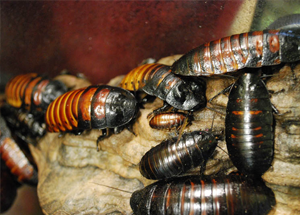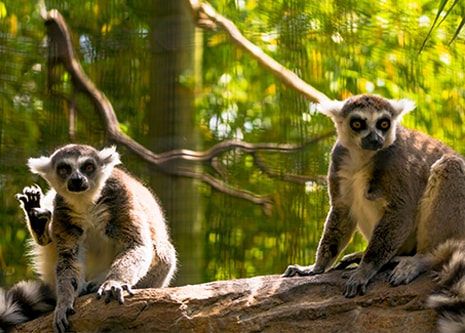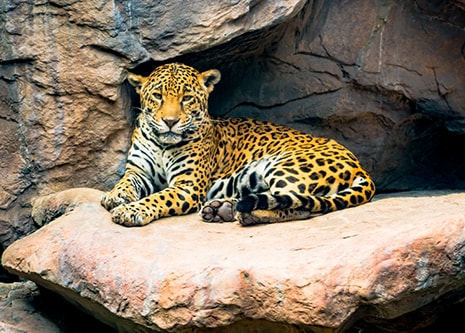
- VisitSupport Happy HollowDONATE TODAYExploreSupport Happy HollowDONATE TODAYLearnSupport Happy HollowDONATE TODAYSupport
-
Today's Hours: 10:00 am to 5:00 pm
Education AmbassadorsMadagascar hissing cockroaches

Scientific name: Gromphadorhina portentosa
Family:Blaberidae
Order: Blattodea
Class: Insecta
Range: Madagascar
Habitat: Tropical Forest and Rainforest
Lifespan: 2 to 3 yearsWhat do they look like?
The Madagascar hissing cockroach is a large species of cockroach, growing up to three inches long. Their exoskeleton (hard outer covering) is shiny and brown, and their head, legs and antennae are black. Like other insects, they have six legs and three body parts – the head, thorax, and abdomen. It can be difficult to see the head, as it is small and carried beneath the pronotum (the first segment of the thorax). In males, the pronotum also bears two “horns,” bumps in their hard exoskeleton, which are used in combat. The females lack these horns, and tend to be a little larger than males. Although quite large, hissing cockroaches are not the biggest of the world’s 5000 species of cockroaches– Australia’s burrowing cockroach, Macropanesthia rhinoceros, is heavier and the giant cockroach from the Caribbean, Blaberus giganteus, is longer.How do they behave?
Madagascar hissing cockroaches are nocturnal (primarily active at night). They are communal and live in family groups with a dominant male presiding. Although they do not have wings and cannot fly, they have several great defenses. Their defenses include being excellent climbers, running very fast, making noise and having a flexible exoskeleton, which enables them to fit into very small spaces. Their name comes from the hissing noise they make. Both males and females will hiss when threatened. The males will also hiss at each other during courtship to compete for females. The noise is produced when they push air out through holes in their sides called spiracles, which are used primarily for breathing.What do they eat?
Madagascar hissing cockroaches are detritivores (animals that eat decomposing plant or animal material), eating fallen vegetation on the rain forest floor and returning nutrients to the soil. At Happy Hollow, they eat fruit and vegetables.How are they born?
Female Madagascar hissing cockroaches will produce around 50 eggs inside an ootheca (a specialized egg-case around one inch long). This species retains the egg case inside her abdomen until they hatch, at which time she gives birth to live young. When the babies are born, they are the size, shape and color of a grain of rice. As the juveniles mature, they molt their exoskeleton several times in order to reach their adult size.Conservation
Madagascar hissing cockroaches have not been evaluated by the International Union for Conservation of Nature . Although their current population is stable, one potential threat to this island dwelling species is habitat loss. If you would like to help Madagascar hissing cockroaches you can purchase coffee that is shade-grown, wood certified by the Forest Stewardship Council, and produce that is grown locally. These products do not require the destruction of rainforest land.
Zoo on the Hill
Located across from the Keep-Around Carousel is the Zoo on the Hill. Learn about wildlife up close during daily meet-and-greets, leap like a lemur on the playground, brush and feed the goats,, or take a peek inside Doc’s Critter Care building and the Ranch House. Double-H Ranch features a combination of animal exhibits, including giant anteaters and red ruffed lemurs, as well chickens and domesticated animals that are docile enough to touch.
See Animals
Zoo in the Hollow
Follow the crooked bamboo pathway down into the hollow and visit with some of the most amazing animals in the world. Where else in San José can you get up close to a stunning jaguar, lemur, meerkat or American alligator? Happy Hollow is dedicated to helping save species and preserve wildlife for future generations by participating in Species Survival Plan programs through the Association of Zoos and Aquariums.
See AnimalsVisit Us Today
Plan an unforgettable experience at San Jose’s family-friendly park and zoo.
more info